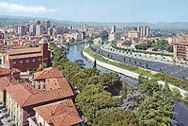


Terni, the provincial capital in the south of Umbria, is on the main line from Rome to Foligno. Its excellent transport links make it a good base for visiting Narni, Amelia, Otricoli, Cesi and Carsulae. Much of the city was destroyed in the bombardment of World War Two, and the rebuilding was in a style that is not to everyone’s taste. However, it has all the benefits of a modern city and there is enough remaining of its past to make it well worth a visit.
Most of the people staying in Terni seem to be on business, but its hotels still work if you are a tourist. I have stayed at:
-
✴Hotel Michelangelo, which is directly opposite the station, and has a nice restaurant; and
-
✴Hotel Valentino, even closer to the city centre. To reach it, take the footpath behind the giant steel press opposite the railway station and walk straight ahead along Via Domenico Mascio and then Via Plinio il Giovane. The hotel is on the left, at the junction with Viale Mazzini.
One of the real plus points about Terni is the number and quality of its restaurants. My favorite is:
-
✴Oste della Mal’ora, 5 Via Tre Archi (0744 406 683).
I have also enjoyed meals at:
-
✴Ristorante la Lumière, 50 Viale della Stazione, which is part of Hotel de Paris (a hotel that I have not yet tried);
-
✴Ristorante il Convivio, 15a Vico Catina, near San Tommaso (0744 471 180);
-
✴Ristorante Tacitus, 14 Piazza Tacito (0744 425 147); and
-
✴Ristorante Via degli Artieri, Piazza Clai (0744 428 612).
There are are number of places in Terni that are particularly good for lunch:
-
✴Caffe Rendez-Vous, 3 Piazza San Francesco, which has a restaurant in the garden behind the bar;
-
✴Risto del Secolo, 90 Corso Tacito, which is Sicilian and serves nice salads (among other more substantial choices);
-
✴Galleria Da. Co., 9 Via del Tribunale;
-
✴Placebo, 45 Via Cavour, a friendly, funky café and wine bar;
-
✴Nero di Cozza, 19 Via Cavour;
-
✴Terrazza Elettra, Via Fratini (0744 420 120); and
-
✴the bar, café and restaurant Pazzaglia (10-14 Corso Tacito), which is named for its founder, Spartaco Pazzaglia and has been a city institution since 1913.
Good places for breakfast include:
-
✴Antico Caffé Metelli, 16 Piazza Tacito;
-
✴Caffé Mazzini, 37 Via Mazzini;
-
✴Caffé Bippi, Piazza Carrara (opposite Palazzo Carrara); and
-
✴Caffé Morandi, 4 Piazza della Repubblica.
The excellent Orient Express, at 107 Via Roma, is a specialist in tea, but it also sells coffee and serves both in its café. I have yet to try either of the bars in the Biblioteca Comunale: the one on the second floor has an open terrace looking down on Piazza Solferino.
On my list for future visits are:
-
✴Al Solito Posto, 16 Vico Catina (near San Tommaso);
-
✴il Vinaio, 22 Via Cavour (0744 423 912);
-
✴Osteria Anfiteatro, 3 Piazza San Giovanni Decollato, where you can eat outside in the quiet piazza behind Palazzo delle Poste (0744 432 521);
-
✴Bistro Met, Piazza Tacito (0744 422 520);
-
✴i Celti, 16 Piazza Clai;
-
✴Mamma Lina, 33 Via dell’ Ospedale (0744 428 833);
-
✴Esattopposto, 21 Via Barnaba Manassei, 21 (340 502 0320);and
-
✴L' Antica Taverna Di Petrucci Fulvio, 27 Via Garibaldi Giuseppe (0744 423 894).
Guides
The best book shop in Terni is Libreria Alterocca.
The most comprehensive written guide is Bruno Toscano, “L’ Umbria: Manuali per il Territorio: Terni”, Rome (1980), in two volumes. It is out of print, but used copies are often advertised on-line.
Useful links
Tourist Information is at Informazioni e Accoglienza Turistica di Terni, 2-4, Via Cassian Bon.
This page from the website of the Comune di Terni has buttons on the left that link to the most important churches, palaces, museums etc. and a calendar on the right that tells you what events are planned.
The webpage of the Diocese of Terni, Narni and Amelia has a number of useful pages, including those on the times of Mass and on the chronology of bishops of the three dioceses.
The website of the Provincia di Terni gives the opening times and other details of the museums in Terni and links to many of the individual museums. The main archeological remains are described in the site of the Soprintendenza per i Beni Archeologici dell'Umbria.
Information on bus services is available on the website of atc.
Terni is well-served by both Trenitalia (the national service) and the Ferrovia Centrale Umbria. (The link to FCU given here also shows the Trenitalia lines through Terni).
Return to the page on Cities of Umbria.

